In 1976 Dutch textile specialist Rens Heringa first visited Kerek in rural East Java and discovered a region where—unlike the rest of Java—the full range of textiles with woven patterning, as well as the only batik still made on handwoven cotton cloth, continued to be produced for local use.
Each type of cloth made in Kerek is created for a specific purpose—to be worn by a person of a particular age, social, or residential group; to serve in life-cycle events such as marriage or funerals; to act as a focal point in agricultural ceremonies or curing rites. The functions, techniques, patterning, and especially the color combinations of the cloth all form part of a highly structured and elaborate system of belief that is remarkably integrated with the community’s social organization, mythology, and ritual practices. Remnants of similarly integrated systems of belief are known from many parts of Java, but by the late 20th century the full system could be observed only in Kerek. Batik from Kerek today represents the antecedents of the courtly and urban batik found in collections around the world.
- ISBN10 0977834425
- ISBN13 9780977834426
- Publish Date 4 August 2010
- Publish Status Active
- Publish Country US
- Imprint Fowler Museum of Cultural History,U.S.
- Format Paperback (US Trade)
- Pages 92
- Language English
